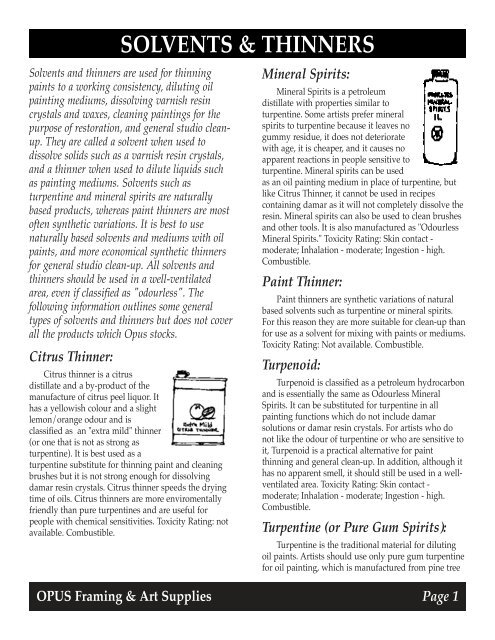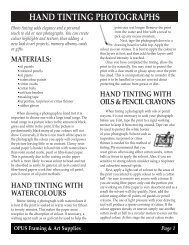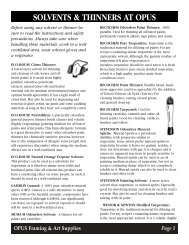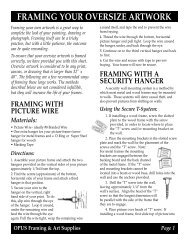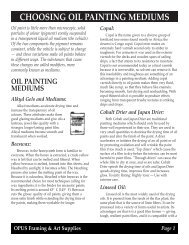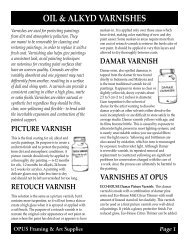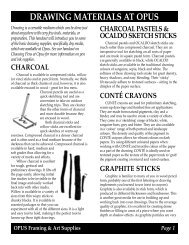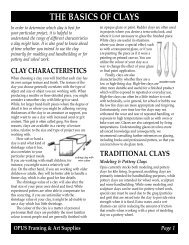Solvents & Thinners - Opus Art Supplies
Solvents & Thinners - Opus Art Supplies
Solvents & Thinners - Opus Art Supplies
You also want an ePaper? Increase the reach of your titles
YUMPU automatically turns print PDFs into web optimized ePapers that Google loves.
<strong>Solvents</strong> and thinners are used for thinning<br />
paints to a working consistency, diluting oil<br />
painting mediums, dissolving varnish resin<br />
crystals and waxes, cleaning paintings for the<br />
purpose of restoration, and general studio cleanup.<br />
They are called a solvent when used to<br />
dissolve solids such as a varnish resin crystals,<br />
and a thinner when used to dilute liquids such<br />
as painting mediums. <strong>Solvents</strong> such as<br />
turpentine and mineral spirits are naturally<br />
based products, whereas paint thinners are most<br />
often synthetic variations. It is best to use<br />
naturally based solvents and mediums with oil<br />
paints, and more economical synthetic thinners<br />
for general studio clean-up. All solvents and<br />
thinners should be used in a well-ventilated<br />
area, even if classified as "odourless". The<br />
following information outlines some general<br />
types of solvents and thinners but does not cover<br />
all the products which <strong>Opus</strong> stocks.<br />
Citrus Thinner:<br />
SOLVENTS & THINNERS<br />
Citrus thinner is a citrus<br />
distillate and a by-product of the<br />
manufacture of citrus peel liquor. It<br />
has a yellowish colour and a slight<br />
lemon/orange odour and is<br />
classified as an "extra mild" thinner<br />
(or one that is not as strong as<br />
turpentine). It is best used as a<br />
turpentine substitute for thinning paint and cleaning<br />
brushes but it is not strong enough for dissolving<br />
damar resin crystals. Citrus thinner speeds the drying<br />
time of oils. Citrus thinners are more enviromentally<br />
friendly than pure turpentines and are useful for<br />
people with chemical sensitivities. Toxicity Rating: not<br />
available. Combustible.<br />
Mineral Spirits:<br />
Mineral Spirits is a petroleum<br />
distillate with properties similar to<br />
turpentine. Some artists prefer mineral<br />
spirits to turpentine because it leaves no<br />
gummy residue, it does not deteriorate<br />
with age, it is cheaper, and it causes no<br />
apparent reactions in people sensitive to<br />
turpentine. Mineral spirits can be used<br />
as an oil painting medium in place of turpentine, but<br />
like Citrus Thinner, it cannot be used in recipes<br />
containing damar as it will not completely dissolve the<br />
resin. Mineral spirits can also be used to clean brushes<br />
and other tools. It is also manufactured as "Odourless<br />
Mineral Spirits." Toxicity Rating: Skin contact -<br />
moderate; Inhalation - moderate; Ingestion - high.<br />
Combustible.<br />
Paint Thinner:<br />
Paint thinners are synthetic variations of natural<br />
based solvents such as turpentine or mineral spirits.<br />
For this reason they are more suitable for clean-up than<br />
for use as a solvent for mixing with paints or mediums.<br />
Toxicity Rating: Not available. Combustible.<br />
Turpenoid:<br />
Turpenoid is classified as a petroleum hydrocarbon<br />
and is essentially the same as Odourless Mineral<br />
Spirits. It can be substituted for turpentine in all<br />
painting functions which do not include damar<br />
solutions or damar resin crystals. For artists who do<br />
not like the odour of turpentine or who are sensitive to<br />
it, Turpenoid is a practical alternative for paint<br />
thinning and general clean-up. In addition, although it<br />
has no apparent smell, it should still be used in a wellventilated<br />
area. Toxicity Rating: Skin contact -<br />
moderate; Inhalation - moderate; Ingestion - high.<br />
Combustible.<br />
Turpentine (or Pure Gum Spirits):<br />
Turpentine is the traditional material for diluting<br />
oil paints. <strong>Art</strong>ists should use only pure gum turpentine<br />
for oil painting, which is manufactured from pine tree<br />
OPUS Framing & <strong>Art</strong> <strong>Supplies</strong> Page 1
esin and carefully distilled. Industrial grade<br />
turpentine, which is generally available in hardware<br />
stores, is produced from tree stumps and contains<br />
impurities and a strong, unpleasant odour. For any<br />
recipes containing damar, for making painting<br />
mediums and varnishes, turpentine is the appropriate<br />
solvent and the only solvent which will dissolve damar<br />
crystals. The gummy residue of turpentine left after<br />
evaporation is harmless, though turpentine is best<br />
when it is fresh. Toxicity Rating: Skin contact -<br />
moderate; Inhalation - moderate; Ingestion - high.<br />
Flammable.<br />
NOTES:<br />
SOLVENTS & THINNERS<br />
OPUS Vancouver OPUS Langley OPUS Victoria<br />
1360 Johnston St 5501 204 Street 512 Herald St<br />
604-736-7028 604-533-0601 250-386-8133<br />
OPUS Kelowna OPUS North Vancouver OPUS National<br />
1357 Ellis St 120 Lonsdale Ave Mail Order Service<br />
250-763-3616 604-904-0447 1-800-663-6953<br />
www.opusframing.com<br />
OPUS Framing & <strong>Art</strong> <strong>Supplies</strong> Page 2


